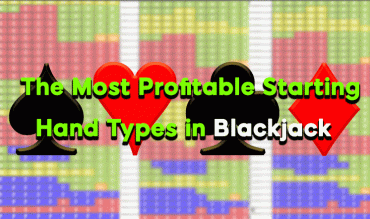- In the game of blackjack, a popular question among novice and intermediate advantage players, card counters, trackers, sequencers and hole carders, is: what is the mathematical theoretical value for various types of starting hands, and more to the point what are the most valuable starting hands for the player (the players first two cards) and by how much
- When I say "types of hands" I mean Hard Totals, Soft Totals, double downs and splits that we can use in our basic blackjack strategy.
The most valuable starting hands in blackjack in order of ascending value to the player is:
- Traditional 21 - Blackjack
- Soft 18 - A soft total of A-7 versus a 7 up card (Doubling)
- Hard 11 - A hard total of 11 against the blackjack dealers 6 up card (Double Down Hand)
- Hard 20 - A Hard total of 20 vs. a dealers 8 up card (Standing)
- Soft 20 - A soft total Ace-9 vs. dealers 8 up card (Standing)
STARTING HAND #1:
SOFT 18
The soft 18 (Ace-7) has a value of 0.3996 of the original bet to the player. This means over the long term the gain the player will gain $39.96 for every 100 dollars wagered. This requires the player to follow the adjusted index numbers and double the bet when the value of the true count is greater than 22 – using the USTON APC count, which is a rare occurrence.
STARTING HAND #2:
HARD 11
The next most valuable first two card total for the player is a hard total of 11, either an (8-3), (9-2), (7-4), (6-5) .These totals have a value of 0.6674 of the original bet to the player. This means over the long term the gain the player will gain $66.74 for every 100 dollars wagered. This requires the player to follow the adjusted index numbers and double the bet when the value of the true count is greater than -16, using the USTON APC count, which is occurs more than 97% the time.
STARTING HAND #3:
HARD 20
The next two card total I will discuss is when the player has a two card hard total of 20, achieved by two 10s. These totals have a value of 0.7918 of the original bet to the player. This means over the long term the gain the player will gain $79.18 for every 100 dollars wagered. This requires the player to never split the 10’s. Splitting 10’s in some instances is mathematically justified but it draws way too much attention and I have decided to omit the index number for this reason.
STARTING HAND #4:
SOFT 20
The final two card total we I will discuss is when the player has a soft total of (Ace-9). This has a total have a value of 0.7918 of the original bet (same as a two card total of 20) for the player. This means over the long term, the gain the player will gain $79.18 for every 100 dollars wagered. This requires the player to double when the index value of 7 is reached using the USTON APC count. This doubling can look natural in some instances, but if the pit is watching closely it would be best to avoid the play.
STARTING HAND #5:
21 (BLACKJACK)
The most profitable hand type in blackjack is the natural 21. In a traditional 21 game the payout for a natural is 3:2, or 1.5 times the player’s original bet. It consists of an ACE and a 10 value card (10, J, Q, K). This hand never loses, it can only tie or win. So the theoretical mathematical value is the best.
SUMMARY
In some cases not making the correct play is in the player’s best interest. You give up a little in EV but you will make it up by not drawing too much suspicion.
In general terms; when the dealer is weak it is better for the player. Up cards of a 5 or 6 is the best possible scenario for a player, with a 6 up card being a slightly more favorable situation. This is because the dealer has the maximum number of cards available to break—where the dealer exceeds 21.
From this we can extrapolate why the 5s and 6s are the most important cards in a shoe.
When the 6 is the dealers up card the maximum number of cards will break the dealer-where they go over 21. 10s are 4 times more likely to be a drawn. This combined with 6, 7, 8 and 9 will break the dealer. Similarly, when a 5 is played, it benefits the player the most. This is because the 5 gives the dealer an extra card to make a hand when they have the weak up card of a 6.
Each starting hand has an associated value with it. This is the percentage of the bet that is won or lost on average and over time. Here I have associated the maximum values a hand types. The Soft Doubling, Hard Doubling and Pairs mentioned here all have positive values associated with them. A hands value is determined by 3 three things. They are the first two cards dealt to the player and the dealers up card. There any number of books where a player can look up the value of whatever hand they choose. These are not the top valued hands because many of the top valued hands are similar in origin. The hand-types approach, gives the aspiring player a better overall understanding of how the types of hands affects the value of the hand.


